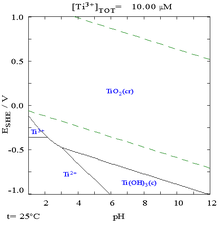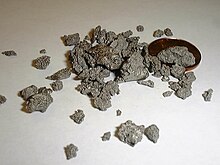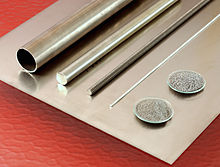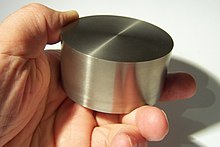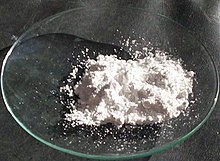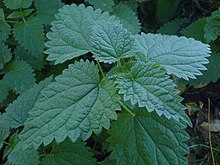Titanium
Titanium is a chemical element with symbol Ti and atomic number 22 that is located in group 4 of the periodic table of elements. It is a transition metal of gray color, low density and great hardness. It is highly resistant to corrosion by seawater, aqua regia and chlorine.
It was discovered independently in 1791 by William Gregor in a mine in Cornwall, Great Britain, and in 1795 by Martin Heinrich Klaproth, who named it "titanium » by the Titans of Greek mythology.[citation needed] This element is abundant in mineral deposits, mainly in the form of oxides such as rutile and ilmenite, widely distributed in the Earth's crust and lithosphere; it is also found in living beings, bodies of water, and extraterrestrial objects. The extraction of this metal from ore is done by the Kroll method or by the Hunter method. The most common compound is titanium dioxide, used for photocatalysis and the manufacture of white pigments. Other common compounds include titanium tetrachloride (TiCl4), a catalyst component, and titanium dioxide. titanium trichloride (TiCl3), which is used as a catalyst in the production of polypropylene.
In its pure state, it has a high resistance to corrosion and the highest hardness-density ratio of all metallic elements. Titanium is as strong as some steels, but its density is lower. It has two allotropic forms. and five naturally occurring isotopes ranging from 46Ti to 50Ti, with 48Ti being the most abundant.
Titanium can form alloys with iron, aluminum, vanadium and molybdenum among other elements, ideal for its lightness and resistance properties for the construction of machinery for aerospace applications —jet engines, missiles and spacecraft—, military, industrial —storage and transportation of chemical and petrochemical products, and desalination plants—, in the automotive industry, for medical prostheses and orthopedic implants, dental instruments and implants, sports equipment, jewelry or mobile phones.
Features
Physical properties
Titanium is the metallic element with the highest hardness-to-density ratio. It is a strong metal, with low density and high ductility (especially in oxygen-free environments), metallic white in color. Its point melting point is relatively high, around 1668 °C (1941 K), making it useful as a refractory metal. It is paramagnetic and has low electrical and thermal conductivity.
Commercial titanium alloys, with a purity of 99.2%, have a tensile strength of about 434 MPa (63,000 psi), equivalent to that of common steel alloys but with a lower density than these. Titanium has a density 60% greater than aluminum, but is twice as strong as the more common aluminum alloy 6061-T6. Some titanium alloys achieve a tensile strength in excess of 1,400 MPa (200,000 psi). However, titanium loses strength when heated to temperatures above 430 °C (703 K). Titanium is not as hard as some grades of treated steel, and machining requires certain precautions, as it can present defective unions if the correct methods are not used to cool it. Like those made of steel, titanium structures have a fatigue limit that guarantees the longevity of their applications.
It is a dimorphic metal allotrope. Its crystal structure in the alpha state is hexagonal in shape and becomes a body-centered cubic in the beta state at a temperature of 882 °C (1155 K). The specific heat of its alpha form increases dramatically. as it is heated to the transition temperature, then lowered and remains relatively constant in the beta form, unaffected by temperature. As for zirconium and hafnium, there is an additional omega phase, thermodynamically stable at high pressures but metastable at pressure environment, which is usually hexagonal or trigonal.
Chemical Properties
Like aluminum and magnesium, titanium and its alloys oxidize when exposed to air. Titanium reacts with oxygen at temperatures of 1,200 °C (1,470 K) in air and 610 °C (883 K) in pure oxygen, forming titanium dioxide. However, oxidation reactions in contact with air and Water are slow, due to passivation which forms an oxide layer that protects the rest of the metal from its own oxidation. Initially, when this protective layer is formed it is only 1–2 nm thick, slowly increasing in size until it is 25 nm over a period of four years.
Titanium has a high resistance to corrosion, comparable to that of platinum, capable of resisting attack by strong mineral acids such as sulfuric and other oxoacids, most organic acids and chlorine solutions. However, concentrated acid attacks do lead to increased corrosion. Titanium is thermodynamically very reactive, as indicated by the fact that the metal begins to burn before reaching the melting point, and melting itself is only possible in an inert atmosphere. or in a vacuum. It combines with chlorine at a temperature of 550 °C (823 K), reacts with the other halogens and absorbs hydrogen.
It is one of the few elements that burn in pure nitrogen, reacting at a temperature of 800 °C (1070 K) to form titanium nitride, which causes a loss of ductility in the material.
Abundance
Titanium always occurs naturally together with other elements. It is the ninth most abundant element and seventh most abundant metal in the earth's crust, accounting for 0.63% of its mass. It is present in most igneous and sedimentary rocks, as well as in various forms of life and natural bodies of water. Of the 801 types of igneous rock analyzed in a study by the United States Geological Survey, 784 contained titanium, and its proportion in soil was found to be between 0.5 and 1.5%.
Its appearance occurs mainly in the minerals anatase, brookite, ilmenite, perovskite, rutile and titanite. Among all these minerals, only rutile and ilmenite are economically important, despite being difficult to find in high concentrations. About six million tons of rutile and about 0.7 million tons of ilmenite were mined worldwide in 2011. The most significant deposits of ilmenite are found in Australia, Canada, China, India, Mozambique, New Zealand, Norway, Ukraine and South Africa. A total of 186,000 tonnes of titanium metal slag was also produced in 2011, mostly in China (60,000 t), Japan (56,000 t), Russia (40,000 t), the United States (32,000 t) and Kazakhstan (20,700 t). The total reserves of titanium on Earth are estimated in that same year to be over 600 million tons.
The molar concentration of titanium in the oceans is about 4 picomoles. At a temperature of 100 °C (373 K) the concentration in water is estimated to be less than 10−7 M at pH 7. There is no evidence to indicate the biological role of titanium, despite the fact that some particular organisms present high concentrations.
This metal has also been detected in meteorites, in the Sun, and in M-type stars, the coldest type of star with a surface temperature of about 3,200 °C (3,470 K). Luna in the Apollo 17 mission are composed of 12.1% TiO2.
Isotopes
Five stable isotopes are found in nature: 46Ti, 47Ti, 48Ti, 49 Ti and 50Ti, being 48Ti the most abundant of them with a 73.8% natural abundance. Eleven radioisotopes were characterized, the most stable being 44Ti with a half-life of 63 years, 45Ti with a half-life of 184.8 minutes, 51Ti with a period of 5.76 minutes and 52Ti with a period of 1.7 minutes. For the rest, their half-lives are less than 33 seconds, with most less than half a second.
Isotopes of titanium have atomic weights ranging from 39.99 Da (40Ti) to 57.966 Da (58Ti). The main decay method before the more abundant stable isotope 48Ti is electron capture, while after it is beta decay. The products of this decay before 48Ti are isotopes of element 21 (scandium), and the later ones are isotopes of element 23 (vanadium). Titanium becomes radioactive when bombarded with deuterium, emitting mainly positrons and gamma rays.
Compounds
The +4 oxidation state dominates the chemistry of titanium, but compounds in the +3 state are also common. Titanium commonly adopts an octahedral coordination geometry in its compounds, with the notable tetrahedral exception of TiCl4. Titanium(IV) compounds have a high degree of covalent bonding due to their high oxidation state.
Oxides, sulfides and alkoxides
The most important oxide of titanium is titanium dioxide TiO2, which exists mainly in anatase, brookite and rutile, all of which are white diamagnetic solids. polymeric structures, in which Ti is surrounded by six oxide ligands that bind to other Ti centers.
The term titanate is often used to refer to titanium(IV) compounds, such as barium titanate (BaTiO3). With a perovskite-like structure, this The material possesses piezoelectric properties and is used as a transducer in the interconversion of sound and electricity. Star sapphires and rubies get their asterism from the presence of impurities in titanium dioxide.
Various reduced oxides of titanium are known. Ti3O5, described as Ti(IV)-Ti(III), is a purple semiconductor produced by reduction of TiO2 with hydrogen at high temperatures, used industrially when it is required to cover surfaces with titanium dioxide vapor, since it evaporates as pure TiO while TiO2 evaporates as a mixture of oxides and other deposits that they have a variable refractive index. Other common oxides are titanium(III) oxide Ti2O3 and titanium(II) oxide TiO.
Titanium(IV) alkoxides, prepared by reacting TiCl4 with alcohols, are colorless compounds that convert to dioxide when reacting with water. They are industrially useful for depositing solid TiO2 by the sol-gel process. Titanium isopropoxide is used in the synthesis of organic compounds by means of Sharpless epoxidation.
Nitrides and carbides
Titanium nitride (TiN) has a hardness equivalent to that of sapphire and silicon carbide (9.0 on the Mohs scale), and is commonly used as a coating for industrial cutting tools. It is used as a gold-colored decorative coating and as a barrier metal in semiconductor manufacturing. Titanium carbide also has high hardness and is also used in cutting tools.
Halides
Titanium tetrachloride TiCl4 is a volatile liquid that in air causes hydrolysis emitting white smoke. TiCl4 is produced by the method of Kroll during the conversion of titanium ores to titanium dioxide. Its use is widespread in organic chemistry as a Lewis acid. Titanium tetraiodide TiI4 is generated during the van Arkel process to the production of high purity titanium metal.
Titanium(III) and titanium(II) also form stable chlorides. A notable example is titanium trichloride, TiCl3, used as a catalyst in the production of polyolefins and as a reducing agent in organic chemistry.
Organometallic compounds
Titanium compounds play an important catalytic role in polymerization, so compounds with Ti-C bonds were intensively studied. The most common compounds of this type are titanocene dichloride ((C5H5)2TiCl2), Tebbe's reagent (C5H5)2TiCH2ClAl(CH3 )2 and the Petasis reagent (Cp2Ti(CH3)2). Titanium also forms carbonyl compounds, such as titanocene dicarbonyl (C5H5)2Ti(CO)2 .
History
Titanium was discovered within an ore in Cornwall, Great Britain, in 1791 by the clergyman and amateur geologist William Gregor, who was then the pastor of the parish of Creed. He recognized the presence of a new element in ilmenite when he found black sand in a stream in Manaccan parish and observed that the sand was attracted to a magnet. His analysis of the sand determined the presence of two metal oxides: iron oxide (causing the magnetic attraction) and a proportion of 45.25% of another white metallic oxide that he was unable to identify. As this unidentified oxide contained a metal that did not meet the properties of any of the known elements, he reported his discovery to the Royal Geological Society of Cornwall and the German scientific journal Crell's Annalen, giving it the name manacanite.
About the same time, Franz-Joseph Müller von Reichenstein produced a similar substance which he was also unable to identify. The oxide was rediscovered independently in 1795 by the Prussian chemist Martin Heinrich Klaproth in a rutile ore in the Hungarian village of Boinik, in present-day Slovakia. Klaproth found that the mineral contained a new element and named it titanium after the titans of Greek mythology. de Gregor, obtained a sample of manacanite and confirmed that it contained titanium.
The known processes for extracting titanium from the various ores that contain it are complicated and expensive. It is not possible to reduce the ore in the usual way by heating it in the presence of carbon, as that produces titanium carbide. Pure titanium metal (99.9%) was first obtained by Matthew La. Hunter at Rensselaer Polytechnic Institute by heating TiCl4 with sodium to 700–800 °C under high pressure, a process known as Hunter's method. Titanium metal was not used outside laboratories until 1932, when William Justin Kroll proved that it could be produced by reducing titanium tetrachloride (TiCl4) with calcium. Eight years later he refined this process using magnesium and sodium, in the which would be known as the Kroll method. Despite the fact that research continued later in the face of more efficient and cheaper production processes, the Kroll method continues to be used in the commercial production of this metal.
High purity titanium was also obtained in small quantities when Anton Eduard van Arkel and Jan Hendrik de Boer developed in 1925 what would be called the van Arkel-de Boer method, which reacted various metals with iodine to decompose the resulting iodides in pure metal filaments.
In the 1950s and 1960s the Soviet Union pioneered the use of titanium in military and submarine applications, such as the Alfa-class submarines and K-278 Komsomolets, as part of war-related programs Cold. Also in the early 1950s, titanium began to be used extensively in military aviation, particularly in high-performance fighters such as the F-100 Super Sabre, Lockheed A-12, and SR-71. Recognizing the strategic importance of titanium, the United States Department of Defense also began supporting early efforts to commercialize it.
Throughout the Cold War, titanium was considered a strategic material by the United States Government, which maintained large reserves of this metal that were finally depleted in the 2000s. According to 2006 data, the largest producer in the world was the Russian company VSMPO-Avisma, which owned 29% of the world market for this material. In that same year, the American agency DARPA awarded 5.7 million dollars to a consortium of two companies to develop a process for manufacturing titanium metal powder, with the purpose of using it in the creation of light and resistant objects for the aerospace, transport and chemical industries. As of 2015, titanium metal sponge was being produced in seven countries: China, Japan, Russia, Kazakhstan, United States, Ukraine and India.
Production
Titanium metal production takes place in four main steps: reduction of titanium ore into a porous sponge form, melting of the sponge, primary fabrication where it is turned into general purpose products such as bars and sheets, and finally the secondary manufacture of the final forms from the primary products.
Since it is not possible to produce it by reducing its dioxide, titanium metal is obtained by reducing TiCl4 titanium tetrachloride with magnesium metal in which it is known as Kroll's method. The complexity of this production process explains the high market value of titanium, despite it being a cheaper process than the Hunter method. To produce the TiCl4 required by the Kroll method a carbonothermal reduction is made in the presence of chlorine. In this process, chlorine gas passes through a hot mixture of rutile or ilmenite in the presence of carbon. After extensive purification by fractional distillation, the TiCl4 is reduced with molten magnesium at 800 °C (1070 K) in an argon atmosphere. The titanium metal thus obtained can be further purified following the method from van Arkel-de Boer, involving a thermal decomposition of titanium tetraiodide.
The most recent production process, called the FFC Cambridge process, uses titanium dioxide powder as a raw material to obtain titanium metal. This process has fewer steps than the Kroll method, requires less time, and allows the production of alloys using certain mixtures of oxide powders. The most common titanium alloys are obtained by reduction, such as in the cases of titanium. cuprotitanium (rutile reduction with added copper), ferrocarbon titanium (ilmenite reduced with coke in an electric kettle), and manganotitanium (rutile with manganese or manganese oxides):
- Titanium ferrocarbonate: 2 FeTiO3 + 7 Cl2 + 6 C → 2 TiCl4 + 2 FeCl3 + 6 CO (900 °C / 1170 K)
- Manganotitanio: TiCl4 + 2 Mg → 2 MgCl2 + Ti (1100 °C / 1370 K)
There are about 50 designated grades of titanium and its alloys, although less than half of these are immediately commercially available. The American Society for Testing and Materials (ASTM) recognizes 31 grades of titanium and alloys, of of which grades 1 through 4 are commercially pure. These four grades are differentiated by the variation in their breaking stress depending on the oxygen content, with grade 1 (0.18% oxygen) being the most ductile and grade 4 (0.40% oxygen) being the most ductile. less ductile. The remaining grades are alloys, each designed for a specific use, either for its ductility, strength, hardness, electrical resistance, resistance to deformation, resistance to corrosion, or a combination of these properties.
ASTM covered grades and other additional alloys are produced to meet SALE-AMS and MIL-T aerospace and military specifications, ESO standards and individual country specifications, as well as proprietary specifications for aerospace, military, medical applications and industrial.
Titanium powder is manufactured using a mass production process known as the Armstrong process, similar to the batch process used in the Hunter method. In this Armstrong process, a stream of titanium tetrachloride gas is added to a stream of molten sodium metal. The resulting sodium chloride and titanium particles are removed by filtering off the extra amount of sodium. The titanium is then separated from the sodium chloride by washing with water. The sodium and chloride by-products are recycled for reuse in this process and in the production of the initial titanium tetrachloride.
In the field of construction and manufacturing, all welding of titanium must be done under inert atmospheres of argon or helium to avoid contamination with atmospheric gases such as oxygen, nitrogen or hydrogen. Otherwise, contamination can cause a variety of undesirable conditions, such as loss of ductility, which in turn can lead to reduced weld integrity and joint failure.
Flat commercial products, such as plates and sheets, can be easily formed, but processing these shapes must take into account that the material possesses a 'memory' of its own. and tends to return to its original shape, a fact that occurs especially in certain very hard alloys.
Titanium cannot be welded without first being plated with a metal that exhibits weldability, and it can be machined with the same type of equipment and processes as stainless steel.
Applications
Titanium is used in steel alloys to reduce grain size and as a deoxidizer, and in stainless steel to reduce its carbon content. Alloys with aluminum, vanadium, copper, iron, manganese, molybdenum and other metals.
Pigments and additives
About 95% of the titanium ore mined from Earth is destined for refining as titanium dioxide (TiO
2), used as a permanent white pigment in paints, toothpastes, and plastics. It is also used in cement, in gems, to achieve opacity in paper, and to increase hardness in graphite fishing rods and in golf clubs.
The powder of TiO
2 is chemically inert, resists deterioration by sunlight, and is highly opaque. This allows the brown or gray chemicals that make up most household plastics to turn bright white. Paint made with titanium dioxide exhibits good resistance to extreme temperatures, and withstands marine environments. Titanium dioxide Pure has a very high refractive index and greater optical dispersion than diamond. In addition to being an important pigment, it is also commonly used in sunscreens.
Aerospace and Nautical Applications
Because of their high ratio of ultimate stress to density, high corrosion resistance, resistance to fatigue and cracking, and the ability to withstand moderately high temperatures without deformation, titanium alloys are commonly used in aircraft, vehicle armor, ships, spacecraft, and missiles. Alloys of titanium with aluminum, zirconium, nickel, and vanadium, among other elements, are used for these applications. Nearly two-thirds of all titanium metal produced is used in aircraft engines and structures, but it is also used in various other components such as critical structural parts, landing gear, exhaust ducts, and hydraulic systems. The SR-71 Blackbird was one of the first aircraft to make extensive use of the titanium as part of its structure, giving way to the use of this material in modern aircraft. Estimates indicate that about 59 t are used on the Boeing 777, 45 t on the Boeing 747, 18 t on the Boeing 737, 32 t on the Airbus A340, 18 t on the Airbus A330 and 12 t on the Airbus A320. The Airbus A380 uses up to around 77 t, including around 11 t in its engines. Regarding engine applications, titanium is used in rotors, compressors and hydraulic system components. 6AL-4V titanium alloys account for almost 50% of all types of alloys used in aeronautical applications. Thanks to its high resistance to corrosion by seawater, titanium is used in the manufacture of drive shafts and cables, in heat exchangers of desalination plants, in seawater coolers in aquariums, lines and hooks, and in divers' knives. It is also used to make casings and other components of marine surveillance and observation devices for scientific use. and military. The former Soviet Union developed techniques for building submarines with hulls made of titanium alloy, and for forging titanium into vacuum tubes.
Industrial applications
Welded pipes and certain equipment made of titanium, such as heat exchangers, tanks, processing vessels and valves, are used in the chemical and petrochemical industries, mainly due to their resistance to corrosion. Certain specific alloys are used in drilling and iron and steel applications for their toughness, corrosion resistance, or a combination of the two. The paper industry uses titanium in processing equipment exposed to corrosive media such as chlorine gases. Other industrial applications of titanium include ultrasonic welding, wave soldering, and sputtering. Titanium tetrachloride TiCl4 is an important intermediate in obtaining titanium dioxide TiO2; it is used in Ziegler-Natta, and is also used in the manufacture of iridescent glass and smoke screens.
Consumer and Architectural Applications
Titanium metal is used in various automotive applications, particularly motorsports and motorcycling, where weight reduction while maintaining strength and rigidity is a critical factor.
This metal is generally too expensive to be commercially lucrative on the general market, except in high-end products. Some Chevrolet Corvette models featured exhaust pipes made from titanium, and the Corvette Z06's supercharged engine uses solid, lightweight titanium inlet valves for increased heat resistance.
Titanium is also used in many sports equipment, such as tennis rackets, golf clubs, lacrosse stick handles, grills for cricket, hockey, lacrosse and American football helmets, and bicycle frames and components. Titanium alloys can also be used in spectacle frames, increasing their cost but achieving a reduction in weight and avoiding possible skin allergies. Much camping gear is made of titanium, including cookware, lanterns, and spikes, which are more expensive than traditional steel and aluminum gear but offer less weight without loss of hardness and strength. Titanium is also used to make horseshoes, which are lighter and more durable than steel.
Due to advances in metal manufacturing techniques and lighter weight compared to more traditional metals, titanium is increasingly used in the manufacture of firearms. For these same reasons it is also used in the manufacture of the casings of certain models of laptop computers. Titanium has also sometimes been used in architectural applications. The 40 m high memorial to Yuri Gagarin in Moscow is made of titanium due to the color of this metal and its association with the aerospace industry.
The Guggenheim Museum in Bilbao and the Cerritos Millennium Library in Cerritos, California, were the first buildings in Europe and North America respectively to be constructed with a titanium panel roof. Other titanium-roofed buildings include the Frederic C. Hamilton in Denver, Colorado and the 107 m tall Monument to the Conquerors of Space in Moscow.
Jewelry
Titanium is commonly used in jewelry designs, thanks to its durability and inert properties that make this metal a good choice to avoid possible allergies and resist water. It can be used in the form of an alloy with gold, commercialized as 24 karat gold, since 1% Ti in the alloy is not enough to lower this grade. The pieces made with this alloy acquire a hardness equivalent to that of 14 carats, thus increasing their durability.
The durability, lightness and resistance of this material make it very useful in the production of watch covers, and some artists have worked with titanium in the production of sculptures, decorative objects and furniture. Due to its inertness and capacity Titanium is a common metal in body piercings, apart from acquiring several colors. The different colors of these are obtained by means of anodizing, varying the thickness of the outer layer of oxide.
Its use in non-legal tender coins and commemorative medals is somewhat less common. As examples, in 1999 Gibraltar released the first titanium coin, in celebration of the new millennium, and the Australian rugby team Gold Coast Titans awarded a pure titanium medal to their player of the year.
Medical applications
Titanium has multiple medical applications due to its biocompatibility, including surgical tools and medical implants. For these purposes, titanium is often used in alloys with 4-6% aluminum and 4% vanadium.
Thanks to this inherent ease of integrating into bone, it is very useful in dental and orthopedic implants, which can have a useful life of up to 30 years. These implants benefit from the low elastic constant that the bone possesses. Titanium to resemble bone as closely as possible. This achieves that the loads are distributed more equitably between the bones and the implant, achieving a lower rate of degradation in the bones and reducing the possibility of medical complications related to the implant itself. However, the rigidity of titanium alloys is twice that of bone, so adjacent bones receive less load and may suffer deterioration.
As a non-ferromagnetic metal, patients with titanium implants can be safely examined by MRI. Preparation of titanium for use in body implants requires it to be treated under a high-temperature plasma arc to remove surface atoms, exposing underlying titanium atoms in the process.
Nuclear waste storage
Titanium's resistance to corrosion led to containers of this material being investigated for use in the long-term storage of nuclear waste, determining that it is possible to manufacture containers that can last up to 100,000 years as long as the process meets a series of certain manufacturing conditions to reduce possible defects. It can also be used as a drip protector on other types of containers to help contain the waste stored in them.
Precautions
Titanium is non-toxic even in large doses and has no natural biological role in the human body. It is estimated that humans ingest 0.8 milligrams of titanium each day, although most of it is subsequently expelled without being absorbed by the body. However, titanium does have a tendency to accumulate biologically in silica-containing tissues, and a 2011 study suggested a possible connection between titanium and yellow nail syndrome. There are also hints of the existence of an unknown mechanism in some plants that would use titanium to stimulate the production of carbohydrates and help them grow, which would explain why many plants contain between 1 and 2 parts per million of titanium, reaching up to 80 parts per million in the genera Equisetum and Urtica. The fungal species Marasmius oreades and Hypholoma capnoides can bioconvert titanium into soils contaminated with this metal. In f In the form of dust or chips, titanium metal presents a significant fire hazard, and when heated in air there is also a risk of explosion. Water and carbon dioxide based fire extinguishing methods are not effective on titanium burning, so the use of class D fire extinguishers is required to deal with fires caused by this metal. When used in the production or handling of chlorine, care must be taken to use titanium only in places where it is not expose to dry chlorine gas, as it may cause a fire. Titanium can also ignite when contacting a surface that has not yet achieved the oxidation state with liquid oxygen.
Contenido relacionado
Topoisomerase
Atomic mass
Molecular biology
